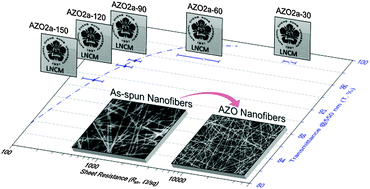Optical and electrical characterization of electrospun Al-doped zinc oxide nanofibers as transparent electrodes
Abstract
Zinc oxide nanofibers with aluminum dopants were successfully fabricated using electrospinning and post-calcination processes with a precise control of the material compositions, nanofiber diameters, and nanofiber depositions. The electrospinning solution was formulated by the dissolution of a zinc powder in poly(acrylic acid) (PAA) to form the PAA/Zn2+ aqueous solution. Aluminum dopants from the addition of aluminum acetate were controlled using Al/Zn atomic ratios ranging between 0 and 5%. For all of the as-spun nanofibers, the average diameters were approximately 120 nm, and the calcined nanofiber diameters were as small as 55 nm after thermal decomposition of the organic content and metal oxide formation during the 500 °C calcination process. Material characterizations revealed that polycrystalline zinc oxide (ZnO) and aluminum-doped ZnO (AZO) had grain sizes ranging from 11 nm to 4.5 nm depending on the aluminum-doping levels. The optical and electric properties of the electrospun ZnO and AZO samples, including the sheet resistance, resistivity, and optical transmittance, were investigated as functions of the doping level and nanofiber deposition. The results indicated that the AZO nanofibers with 2 at% doping exhibit optimal electrical performance. As transparent electrodes, the electrospun AZO nanofibers demonstrated a 190 Ω sq−1 sheet resistance under 91% diffusion transmittance or 84% direct transmittance.


 Please wait while we load your content...
Please wait while we load your content...